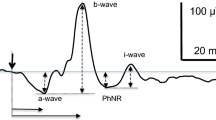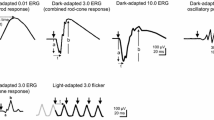Abstract
The amplitude versus flash strength curve of 15 Hz electroretinograms (ERGs) shows two minima. The minima are caused by interactions between the primary and the secondary rod pathways (first minimum), and the secondary rod pathway and the cone-driven pathway (second minimum). Furthermore, cone pathway contributions cause higher-order harmonics to occur in the responses. We measured 15 Hz ERGs in 20 healthy subjects to determine normal ranges and in patients to verify our hypotheses on the contributions of the different pathways and to investigate the clinical application. We analyzed the amplitudes and phases of the 15, 30, and 45 Hz components in the ERGs. The overall shape of the 15 Hz amplitude curves was similar in all normal subjects and showed two minima. The 30 and 45 Hz amplitude curves increased for stimuli of high flash strengths indicating cone pathway contributions. The 15 Hz amplitude curve of the responses of an achromat was similar to that of the normal subjects for low flash strengths and showed a minimum, indicating normal primary and secondary rod pathway function. There was no second minimum, and there were no higher-order harmonics, consistent with absent cone pathway function. The 15 Hz ERGs in CSNB1 and CSNB2 patients were similar and of low amplitude for flash strengths just above where the first minimum normally occurs. We could determine that in the CSNB1 patients, the responses originate from the cone pathway, while in the CSNB2 patients, the responses originate from the secondary rod pathway.









Similar content being viewed by others
References
Bloomfield SA, Dacheux RF (2001) Rod vision: pathways and processing in the mammalian retina. Prog Retin Eye Res 20(3):351–384
Volgyi B, Deans MR, Paul DL, Bloomfield SA (2004) Convergence and segregation of the multiple rod pathways in mammalian retina. J Neurosci 24(49):11182–11192
Wassle H (2004) Parallel processing in the mammalian retina. Nat Rev Neurosci 5(10):747–757
Stockman A, Sharpe LT, Zrenner E, Nordby K (1991) Slow and fast pathways in the human rod visual system: electrophysiology and psychophysics. J Opt Soc Am A 8(10):1657–1665
Stockman A, Sharpe LT, Ruther K, Nordby K (1995) Two signals in the human rod visual system: a model based on electrophysiological data. Vis Neurosci 12(5):951–970
Sharpe LT, Stockman A (1999) Rod pathways: the importance of seeing nothing. Trends Neurosci 22(11):497–504
Stockman A, Sharpe LT (2006) Into the twilight zone: the complexities of mesopic vision and luminous efficiency. Ophthalmic Physiol Opt 26(3):225–239
Bijveld MMC, Kappers AML, Riemslag FCC, Hoeben FP, Vrijling ACL, van Genderen MM (2011) An extended 15 Hz ERG protocol (1): the contributions of primary and secondary rod pathways and the cone pathway. Doc Ophthalmol. doi:10.1007/s10633-011-9292-z
Ruther K, Sharpe LT, Zrenner E (1994) Dual rod pathways in complete achromatopsia. Ger J Ophthalmol 3(6):433–439
Scholl HP, Langrova H, Weber BH, Zrenner E, Apfelstedt-Sylla E (2001) Clinical electrophysiology of two rod pathways: normative values and clinical application. Graefes Arch Clin Exp Ophthalmol 239(2):71–80
Zeitz C, van Genderen M, Neidhardt J, Luhmann UF, Hoeben F, Forster U, Wycisk K, Matyas G, Hoyng CB, Riemslag F, Meire F, Cremers FP, Berger W (2005) Mutations in GRM6 cause autosomal recessive congenital stationary night blindness with a distinctive scotopic 15-Hz flicker electroretinogram. Invest Ophthalmol Vis Sci 46(11):4328–4335
Littink KW, van Genderen MM, Collin RW, Roosing S, de Brouwer AP, Riemslag FC, Venselaar H, Thiadens AA, Hoyng CB, Rohrschneider K, den Hollander AI, Cremers FP, van den Born LI (2009) A novel homozygous nonsense mutation in CABP4 causes congenital cone-rod synaptic disorder. Invest Ophthalmol Vis Sci 50(5):2344–2350
van Genderen MM, Bijveld MM, Claassen YB, Florijn RJ, Pearring JN, Meire FM, McCall MA, Riemslag FC, Gregg RG, Bergen AA, Kamermans M (2009) Mutations in TRPM1 are a common cause of complete congenital stationary night blindness. Am J Hum Genet 85(5):730–736
Scholl HP, Langrova H, Pusch CM, Wissinger B, Zrenner E, Apfelstedt-Sylla E (2001) Slow and fast rod ERG pathways in patients with X-linked complete stationary night blindness carrying mutations in the NYX gene. Invest Ophthalmol Vis Sci 42(11):2728–2736
Scholl HP, Besch D, Vonthein R, Weber BH, Apfelstedt-Sylla E (2002) Alterations of slow and fast rod ERG signals in patients with molecularly confirmed stargardt disease type 1. Invest Ophthalmol Vis Sci 43(4):1248–1256
Khan NW, Kondo M, Hiriyanna KT, Jamison JA, Bush RA, Sieving PA (2005) Primate retinal signaling pathways: Suppressing on-pathway activity in monkey with glutamate analogues mimics human CSNB1-NYX genetic night blindness. J Neurophysiol 93(1):481–492
Dryja TP, McGee TL, Berson EL, Fishman GA, Sandberg MA, Alexander KR, Derlacki DJ, Rajagopalan AS (2005) Night blindness and abnormal cone electroretinogram ON responses in patients with mutations in the GRM6 gene encoding mGluR6. Proc Natl Acad Sci USA 102(13):4884–4889
Gregg RG, Kamermans M, Klooster J, Lukasiewicz PD, Peachey NS, Vessey KA, McCall MA (2007) Nyctalopin expression in retinal bipolar cells restores visual function in a mouse model of complete X-linked congenital stationary night blindness. J Neurophysiol 98(5):3023–3033
Zeitz C (2007) Molecular genetics and protein function involved in nocturnal vision. Ex Rev Op 2(3):467–485
Marmor MF, Fulton AB, Holder GE, Miyake Y, Brigell M, Bach M (2009) ISCEV standard for full-field clinical electroretinography (2008 update). Doc Ophthalmol 118(1):69–77
Miyake Y, Yagasaki K, Horiguchi M, Kawase Y, Kanda T (1986) Congenital stationary night blindness with negative electroretinogram. A new classification. Arch Ophthalmol 104(7):1013–1020
Dawson WW, Trick GL, Litzkow CA (1979) Improved electrode for electroretinography. Invest Ophthalmol Vis Sci 18(9):988–991
Hahn GJ, Shapiro SS (1994) Statistical models in engineering. Wiley, Hoboken
Meigen T, Bach M (1999) On the statistical significance of electrophysiological steady-state responses. Documenta Ophthalmologica 98(3):207–232
Batschelet E (1981) Circular statistics in biology. Academic Press, London
Zar JH (1999) Biostatistical analysis. Pearson Prentice-Hall, Upper Saddle River
Hochstein GD, Molnar FE, Marmor MF (2007) Intrasession variability of the full-field ERG. Documenta Ophthalmologica 115(2):77–83
Curcio CA, Sloan KR, Kalina RE, Hendrickson AE (1990) Human photoreceptor topography. J Comp Neurol 292(4):497–523
Kolb H (1977) The organization of the outer plexiform layer in the retina of the cat: electron microscopic observations. J Neurocytol 6(2):131–153
Bloomfield SA, Völgyi B (2009) The diverse functional roles and regulation of neuronal gap junctions in the retina. Nat Rev Neurosci 10(7):495–506
Odom JV, Reits D, Burgers N, Riemslag FC (1992) Flicker electroretinograms: A systems analytic approach. Optom Vis Sci 69(2):106–116
Eksandh L, Kohl S, Wissinger B (2002) Clinical features of achromatopsia in Swedish patients with defined genotypes. Ophthalmic Genet 23(2):109–120
Hess RF, Mullen KT, Sharpe LT, Zrenner E (1989) The photoreceptors in atypical achromatopsia. J Physiol (Lond) 417:123–149
Nishiguchi KM, Sandberg MA, Gorji N, Berson EL, Dryja TP (2005) Cone cGMP-gated channel mutations and clinical findings in patients with achromatopsia, macular degeneration, and other hereditary cone diseases. Hum Mutat 25(3):248–258
Kohl S, Marx T, Giddings I, Jägle H, Jacobson SG, Apfelstedt-Sylla E, Zrenner E, Sharpe LT, Wissinger B (1998) Total colourblindness is caused by mutations in the gene encoding the α-subunit of the cone photoreceptor cGMP-gated cation channel. Nat Genet 19(3):257–259
Komáromy AM, Alexander JJ, Rowlan JS, Garcia MM, Chiodo VA, Kaya A, Tanaka JC, Acland GM, Hauswirth WW, Aguirre GD (2010) Gene therapy rescues cone function in congenital achromatopsia. Hum Mol Genet 19(13):2581–2593
Moskowitz A, Hansen RM, Akula JD, Eklund SE, Fulton AB (2009) Rod and rod-driven function in achromatopsia and blue cone monochromatism. Invest Ophthalmol Visual Sci 50(2):950–958
Khan NW, Wissinger B, Kohl S, Sieving PA (2007) CNGB3 achromatopsia with progressive loss of residual cone function and impaired rod-mediated function. Invest Ophthalmol Visual Sci 48(8):3864–3871
MacLeod DI (1972) Rods cancel cones in flicker. Nature 235(5334):173–174
Goldberg SH, Frumkes TE, Nygaard RW (1983) Inhibitory influence of unstimulated rods in the human retina: evidence provided by examining cone flicker. Science 221(4606):180–182
Alexander KR, Fishman GA (1984) Rod-cone interaction in flicker perimetry. Br J Ophthalmol 68(5):303–309
Coletta NJ, Adams AJ (1984) Rod-cone interaction in flicker detection. Vision Res 24(10):1333–1340
Specht D, Wu S, Turner P, Dearden P, Koentgen F, Wolfrum U, Maw M, Brandstätter JH, Dieck ST (2009) Effects of presynaptic mutations on a postsynaptic Cacna1s calcium channel colocalized with mGluR6 at mouse photoreceptor ribbon synapses. Invest Ophthalmol Visual Sci 50(2):505–515
Acknowledgments
This study was partially funded by ODAS.
Conflict of interest
None.
Author information
Authors and Affiliations
Corresponding author
Rights and permissions
About this article
Cite this article
Bijveld, M.M.C., Riemslag, F.C.C., Kappers, A.M.L. et al. An extended 15 Hz ERG protocol (2): data of normal subjects and patients with achromatopsia, CSNB1, and CSNB2. Doc Ophthalmol 123, 161–172 (2011). https://doi.org/10.1007/s10633-011-9293-y
Received:
Accepted:
Published:
Issue Date:
DOI: https://doi.org/10.1007/s10633-011-9293-y




